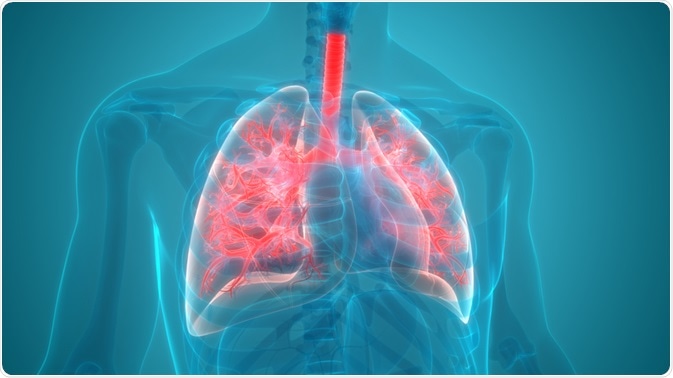Pneumonia is an acute infection of the lungs that produces coughing, fever, chills, muscle aches, and difficulty breathing in those who suffer from it.
The pneumonic infection has been noted throughout human history, with mentions of the disease appearing during early Greek civilization. However, despite our long history with the disease, pneumonia remains a serious medical concern throughout the global community today, with millions of cases of pneumonia-related hospitalizations and deaths worldwide.
Each year, over 1.5 million children die of pneumonia, mostly within developing nations.
Increasing our understanding of both the primary causative agent, Streptococcus pneumonia, and how we as a society have handled the management and treatment of pneumonia on a global scale may help us to increase access and efficiency of treatment options and to someday severely reduce the detrimental effects of the disease.
 Image Credit: Magic mine / Shutterstock.com
Image Credit: Magic mine / Shutterstock.com
Discovery of Streptococcus pneumonia
The bacteria Streptococcus pneumonia is one of the most common causes of pneumonia throughout the world. The Discovery of the bacteria occurred in 1881 when French microbiologist, Louis Pasteur, and American microbiologist, George Sternberg, each independently identified lancet-shaped bacteria in saliva.
Each researcher injected the saliva into rabbits and was later able to isolate elongated diplococci bacteria, that is, oval-shaped bacteria occurring in pairs. Later studies determined the pathogenic potential of the bacteria, identifying it as the causative agent in pneumonia infection in humans.
In the late 1800s, Christian Gram used S. pneumonia to establish his cell wall staining technique, which is now known as Gram staining and identified the bacterium as gram-positive.
Additional studies performed in the early 1900s revealed how the bacteria’s physical structure determined its interaction with the immune system. The cell wall of Streptococcus pneumonia is encapsulated, meaning that it is surrounded by a thick layer of polysaccharides.
This protective layer is associated with increased pathogenicity and limits the way in which the immune system can fight off the bacteria.
Encapsulated bacteria can only be destroyed by the immune system via B cell production of antibodies, and studies by Heidelberger and Avery in 1923 were instrumental in furthering our understanding of antibody immunity and serotypes.
Pneumonia as a public health initiative
During the late 1800s and early 1900s, pneumonia was the leading cause of death due to infectious disease and the third leading cause of death overall.
Treatment of patients with pneumonia became a serious public health initiative. It was during this time period when many infectious agents were being identified, and serious thought was being given on how best to attack the pathogens and provide relief to patients.
A novel technique called antiserum therapy soon began, and by 1913, anti-pneumococcal serum therapy, if given early in disease progression, was able to reduce mortality from 25% to 7.5%. However, this treatment method was slow, costly, and time-consuming.
In the 1930s, the first antibacterial agent, sulfapyridine, was introduced. Although sulfapyridine gained a lot of notoriety when it was used to treat Winston Churchill’s bacterial pneumonia in 1942, this agent was quickly set aside upon the discovery of the antibiotic penicillin in the early 1940s.
Pneumonia - causes, symptoms, diagnosis, treatment, pathology
The use of antibiotics as a treatment strategy for pneumonia continued throughout the 1900s. However, widespread overuse of antibiotics led to the creation of penicillin-resistant strains of Streptococcus pneumonia, which was of great concern to the medical community.
Today, many pneumonia-causing pathogens, particularly those found in hospital settings, are resistant to all but the strongest forms of antibiotics.
A vaccine to protect against bacterial pneumonia was first developed in 1977 and was called the pneumococcal polysaccharide vaccine (PPV). However, this vaccine only protected against a limited number of Streptococcal serotypes.
In 2000, a second vaccine, pneumococcal conjugate vaccine (PCV), offered protection against many more serotypes, including several strains that were resistant to antibiotics.
Today, almost all children in developed nations are given the PCV, and global initiatives are in place to try to increase vaccination rates worldwide and lower childhood mortality. For example, the World Health Organization’s Millennium Development Goal 4 (MDG4) is a worldwide initiative to decrease the under age 5 mortality rate by two-thirds during the period of 1990 and 2015.
References
- http://www.ncbi.nlm.nih.gov/pmc/articles/PMC1449499/
- http://www.ncbi.nlm.nih.gov/pmc/articles/PMC2401909/
- http://www.ncbi.nlm.nih.gov/pubmed/17379493
- http://www.cdc.gov/vaccines/pubs/pinkbook/downloads/pneumo.pdf
- http://profiles.nlm.nih.gov/CC/G/M/G/F/_/ccgmgf.pdf
- https://www.cdc.gov/
Further Reading
Last Updated: Jul 21, 2023